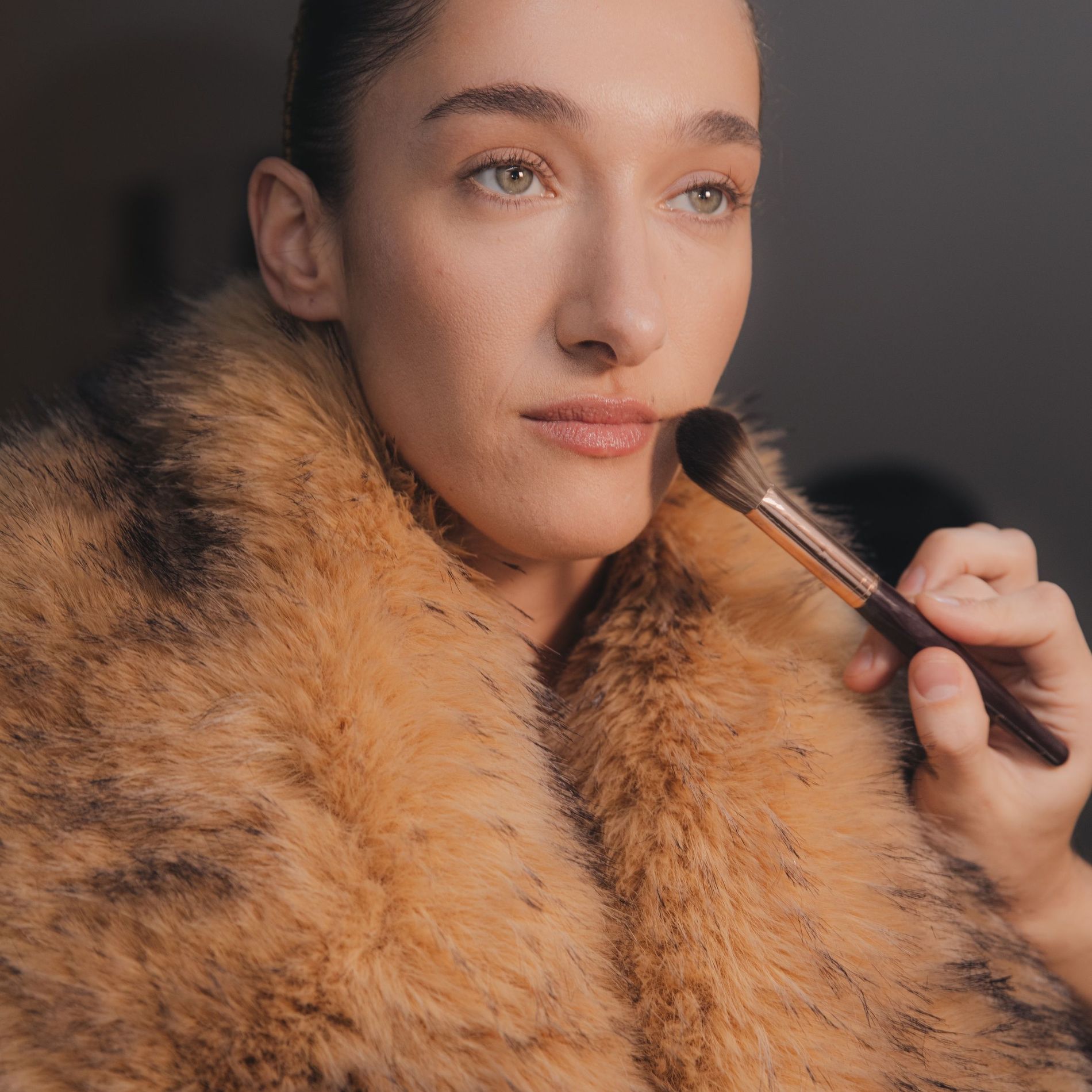Not all powders are created equal, and it’s time you knew why. Below, you’ll discover precisely when to unleash setting powder’s oil‑banishing grip and when to call on finishing powder’s soft‑focus haze – plus the pro tap, press, and dust moves that keep your base flawless from dawn till dusk
What is setting powder and how do you use it?
Setting powder is all about lock‑and‑load: “The purpose of a setting powder is to set the foundation and make it last longer; they often have a mattifying effect and oil‑controlling ingredients,” says Swedish celebrity makeup artist and the founder of LH cosmetics, Linda Hallberg. In practice, it tames any excess sheen, banishes creasing under the eyes, and keeps cream products from sliding off by midday.
But it’s not a one‑and‑done sweep. Mac Cosmetic’s Danish global senior pro artist, Vilde Feste, reminds us that proper application is key: “Setting powder is used to lock makeup in place, prevent creasing and control oil. It helps extend the wear of your base and comes in both loose and pressed formulas.” The trick? Tap a fluffy brush into the powder, whisper off any excess, then press and roll across your T‑zone and under‑eye area rather than dragging. Use it after cream blushes or highlighters to keep everything locked in place or on oily zones to nip midday shine in the bud.
In short: You’ll reach for setting powder whenever you layer creams or need to silence shine under bright lights. It’s that dependable first line of defence against slip‑and‑slide makeup.
What is finishing powder and how do you use it?
If setting powder is the workhorse, finishing powder is that final flourish. “A finishing powder can, of course, also set the foundation, although it’s not their purpose,” says Hallberg. Lightweight and ultra‑fine finishing powders blur pores, soften lines, and give skin that “soft‑focus” look without adding extra coverage.
Feste breaks it down: “Finishing powder is the final step for a polished, airbrushed effect, sometimes with a slight luminous or hydrating finish.” Dust it across cheekbones, down the bridge of your nose, even over shadowy creases left by cream contour or sweep it over your entire look after bronzer and blush to even out any textural inconsistencies
And when you really need your face to look flawless all day? Tilbury’s “sandwich” hack is gold: fix your look with a spritz of setting spray, sweep on finishing powder, then mist again. “I recently did this on Demi Moore and she looked airbrushed!”
Key differences between setting and finishing powders
Setting and finishing powders may look similar, but they serve distinct steps in your routine. “For me, setting powder is a step I do right after my foundation and concealer to keep the product from sliding or creasing. Finishing powder is a step I do at the end, after blush and bronzer, to harmonize all the colours so that the colour appears to emanate from within rather than just sitting on top. It more or less functions like a ‘filter,’ without the word’s negative connotation,” says Sheena Zadeh, founder of complexion-obsessed US brand Kosas.
Formulation plays a part: setting powders lean into talc or oil‑absorbers; finishing powders favour ultra‑fine silica or light‑reflecting pearls. Yet both can be loose or pressed, tinted or translucent. “I would say that finishing, setting and face powders ultimately serve a similar purpose: to mattify the complexion, perfect the look of skin and set liquid complexion products like concealer,” says Tilbury. “Modern powders often combine the benefits of both,” adds Bøg. “They mattify, set the makeup, and provide a blurred, soft‑focus effect.”
Finish and layering are where the two really diverge. Setting powder delivers a matte, “locked‑in” base while finishing powder imparts a final soft‑focus blur that smooths over pores and fine lines. “When choosing a powder, I always ask: Why do you want to use it? Is it for longevity, a blurring effect, or quick touch‑ups throughout the day? Defining your goal makes it easier to pick the right product,” adds Feste.
When to reach for each powder
Use setting powder when…
You’re building a long‑wear foundation look that needs extra grip and oil control. Setting powder is your best friend for locking cream products (think liquid blush, cream bronzer, or high‑coverage foundation), so they stay put from morning meetings to after‑work drinks. It’s also ideal under the eyes to prevent concealer from creasing and across the T‑zone to nip excess shine before it starts.
Use finishing powder when…
You want that Instagram‑ready, soft‑focus finish or when you need a quick mid‑day touch‑up. Finishing powder is perfect for blurring pores, evening out texture, and giving skin a gentle glow (or matte veil, depending on the formula) without piling on more product. Reach for it at the very end (after bronzer, blush, and highlight) for a final diffused sheen or to refine your look under bright lights or in photos.
